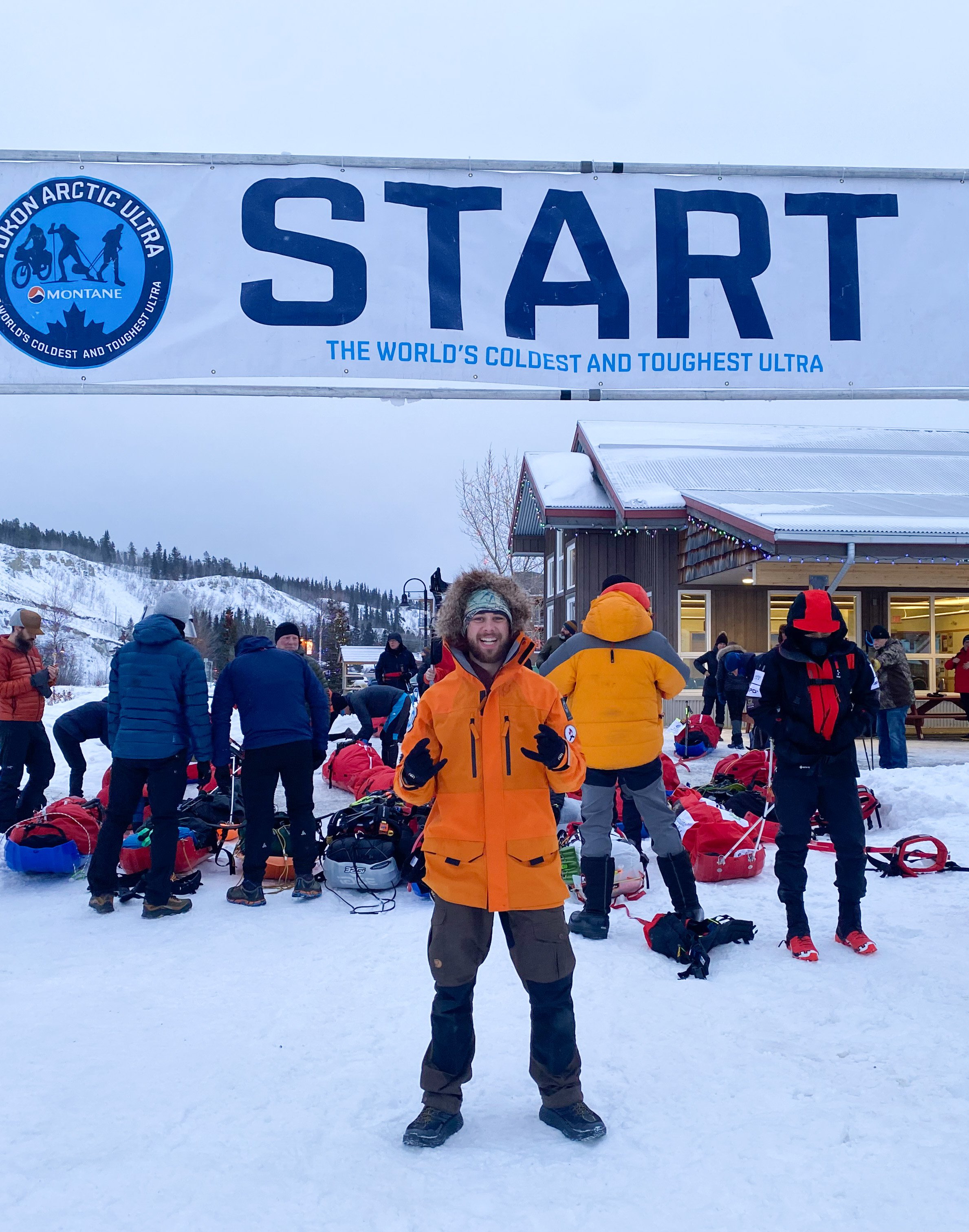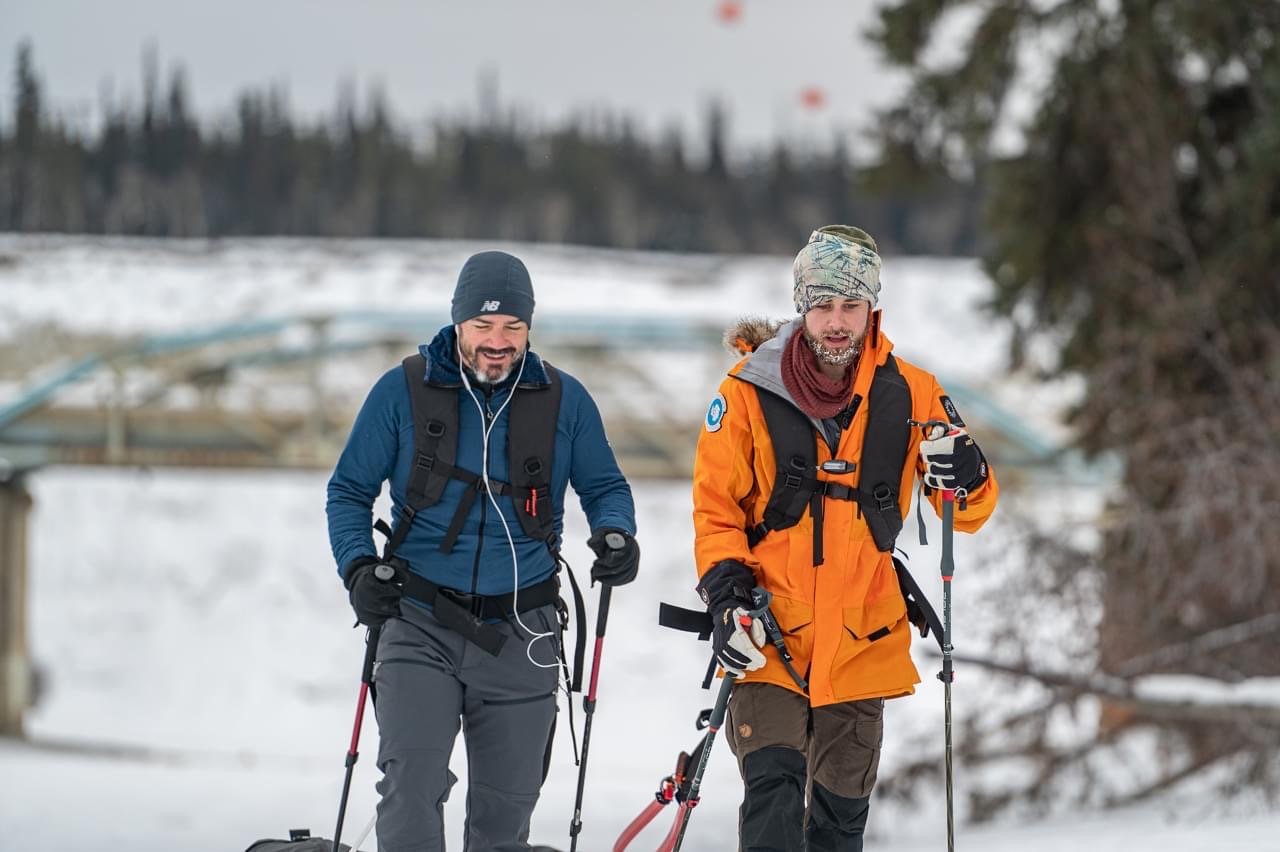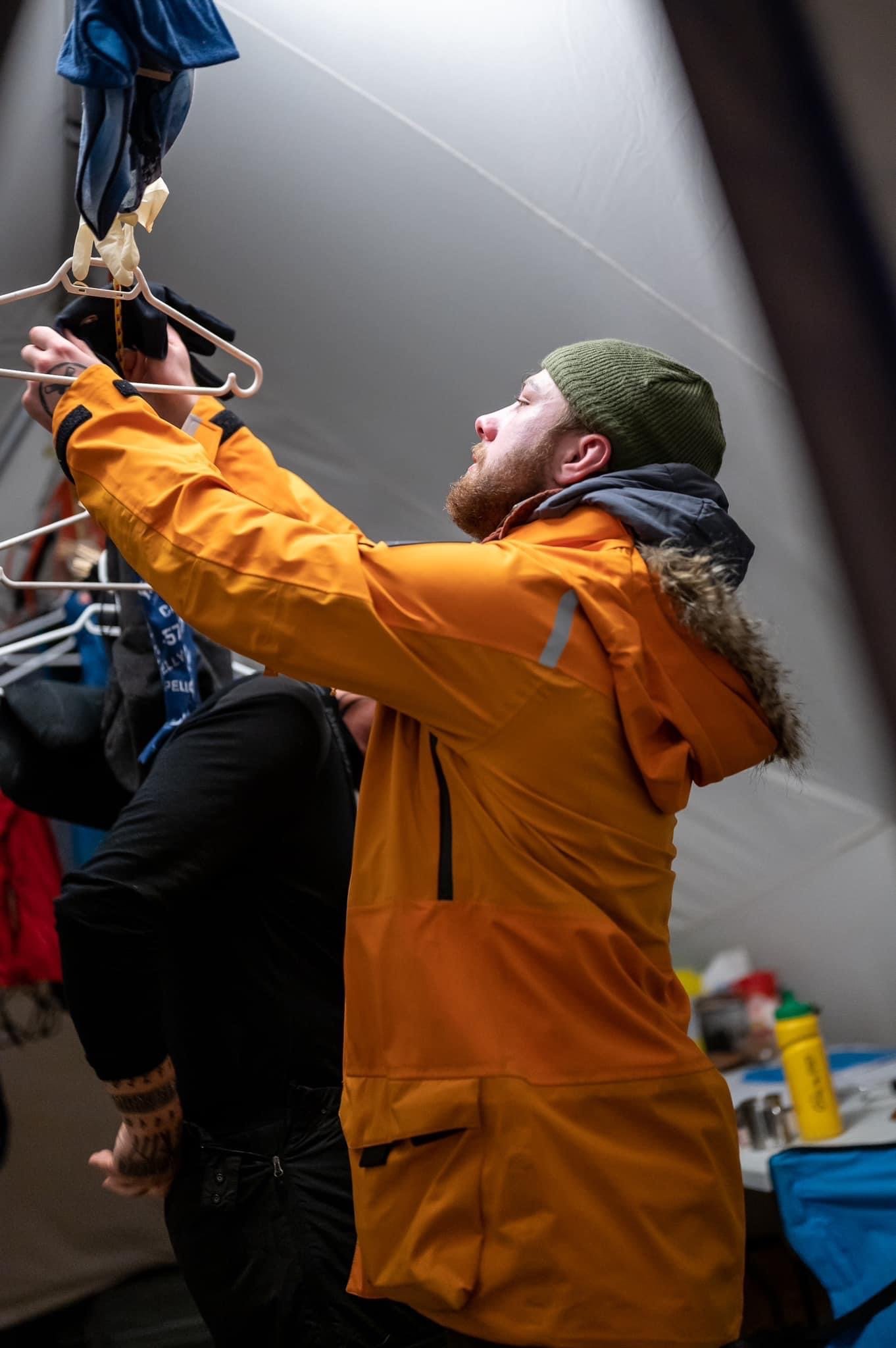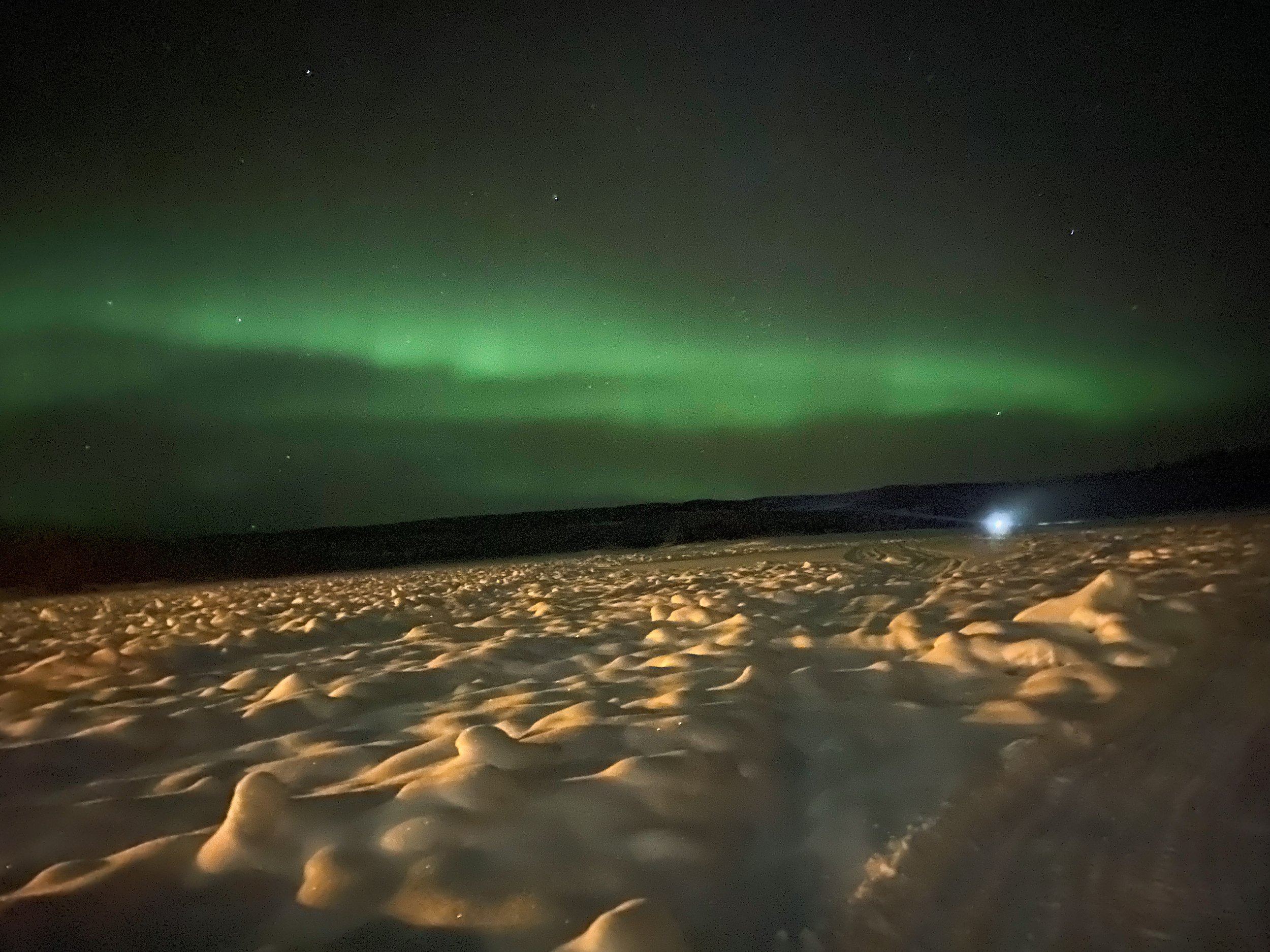Cold Walkings: The Montane Yukon Arctic Ultra
Note: Squarespace is not allowing me to add captions to the photos. The vast majority of them were taken by the race photographer, mark kelly, as well as the race’s social media manager, Callum joliffe
It’s Saturday, February 4th, and I find myself standing within a crowd of sleds and microspikes by the Yukon River. Waiting for the race to start felt like an eternity, but once it did the entire year of planning and training I had put into this race seemed to dissipate. Picking up my life and moving to Montana where I knew no one, all the miles ran through the mountains, the gear meticulously tested, and the Winter spent dragging my tire up Drinking Horse Mountain before I’d kneel in the creek felt like a mere instant at this point.
I stood at the front of the pack excited for the journey ahead and very confident. Robert, the race director, counted down from 10 and unleashed a mob of us onto the river as we pressed toward the first aid station. I remember feeling those first footsteps on the ice crunching under my feet as I ran to create some distance between myself and the other racers. I felt perfectly present in that moment. I think that’s one of the things I enjoy most about ultrarunning anyways. My day-to-day life of balancing relationships and my training schedule against the permanently increasing pressure to keep my expedition to Antarctica relevant fades away, and from the moment the gun goes off until the moment I cross that finish I line I live with absolute purpose. The only thing in the world that exists is forward motion.
I cruised those first 3 or so miles with Tommy Chen, and where one would expect the air to be filled with cold competitiveness, it was actually a lot more fist bumps and laughing than anything else. I asked him about how it felt running a race like this where the solitude and cold of night were quickly cut out by the flash of cameras from his media team near every aid station. He said he was cool with it.
Tommy is a bit faster than me, and so the gap between us grew within the first couple hours and I lost sight of him. That’s to be expected in a race that spans more than a week, but I imagined I’d see him again. I settled into my cadence now that the excitement of the start was over and tried to focus on my strategy. “One hour at a time leads to an aid station. About one aid station per day. Enough days and I will complete the journey.”
The First Night
It felt like the gun had barely gone off by the time I reached MukTuck, but since night was going to fall soon I decided to partner up before leaving the aid station — and that’s when I met my new buddy, Brian!
Brian is a retired Canadian army dude who brings value into his life by taking on crazy difficult athletic feats. Various Triathlons, ultramarathons, and now the MYAU (which is really its own kind of thing) make up his repertoire. The guys looks giddy when he walks. There’s a little pop in his step, and very rarely did I see him deviate from his consistent pacing. He was a man at work for sure. We chatted about the race, why we were there, future endeavors, and all the millions of things you can think to share while plowing forward across a frozen river in the darkness of the Arctic Winter.
It astounds me how comfortable we can get with being uncomfortable. After the course turns off the Yukon River it cuts across a parking lot which serves as a safety net should any racers need to pull out on the first night. For us it was a place with friendly medical staff to have a laugh with while we ate our dinner and set off to finishing our first night shift. The medics poked at me for my handfuls of trail mix while Brian had a chemical-heated MRE. This was where I had my first reminder of the respect this cold environment demanded. My hands had sweat through my liner gloves, and in a matter of a minute ice began forming overtop my knuckles. At first I was mesmerized watching frozen crystals grow in real time, but the beauty faded quickly once the sting of the Arctic’s handshake took hold of my fingers with a death grip. My hands screamed for a moment and then went numb. I pushed my knuckles together to break the thin layer of ice that now restricted me from closing my hands, threw my arms down in a windmill motion to force warm blood back into the fingertips, and stuck my hands inside my expedition down jacket against my body for a minute until I felt like I could move them well again. I was ready to go, and Brian seemed eager to take off as well, so we threw our food bags in the front of our pulks and marched into the woods.
That night felt so good. Almost too good. Brian bedded down at 2:00 AM while I wanted to press on until 4:00. I rolled up and over the endless series of forested hills that dotted this section preceding the Dog Grave Lake Aid Station. I went to bed feeling confident and not too tired. In fact, I was quite proud of the difference this 18 hours of sledging felt on my legs compared to how it would’ve felt when I first started ultrarunning two years ago.
I got up from camp quickly and tried to get moving so I wouldn’t get too cold fiddling with my bivvy and other gear. I suppose my pace had dropped to some degree in those last hours before sleeping because I had hoped to reach Dog Grave lake within an hour of waking up and felt the blows of disappointment get stronger as the sun rose as I hadn’t seen any signs of civilization. The golden rule of this race is probably the hardest to follow; “You are always further away than you think,” and boy was that true.
Dog Grave Lake came into view around 11:00 or so, and by this point Brian had caught me again and we rolled into camp excited for hot drinks, a nice meal, and a little midday rest. The medics looked over my hands and feet for any signs of frostbite or blistering, and once they gave me the ok I went about drying all my gear by the fire (your boy has some painfully sweaty feet). Everyone at camp was in such high spirits as we all had finally gotten through all those rolling hills in the night.
I finished my meal, threw on some fresh socks, and made my way out of camp around 12:30. The afternoon temps were comfortable enough for me to take my parka off, and the trail was relatively uniform as it cut straight through dense forest and skirted alongside frozen lakes. My goal was to make it to Braeburn, the 100-mile checkpoint, by the following morning.
A Walk in the Woods
This time of year the Yukon has 15-hours of darkness, and that can be a lot to take in all at once. With my hood on I can only see the bouncing of my headlamp which reveals the next 15-feet of trail. The whumpfing of the snow under my feet is typically the only thing that breaks the intense silence of the Arctic night. The only sensations to keep me alert is the cold air stinging my nose and the occasional stiffening of my mouth as ice forms across my mustache and limits my range. This race, for the vast majority of my time, was an adventure into myself. Everything in the entire world ceased to exist outside of the hypnotic bouncing of my headlamp and the knowledge that the only way to maintain my body temperature was to keep moving. My headphones, old as they are, couldn’t seem to operate in the cold, and so I ventured inward during this long walk with no music or any other forms of distraction. There were powerful moments in there, some very cathartic, and some intimidating. I encourage anyone looking to step onto this course to work through whatever is necessary to get comfortable with being alone and vulnerable with themselves for a long period of time.
In order to give myself some reprieve from this intense experience, I cut my day into three shifts: Night shift 1, day shift, and night shift 2. If I get to sleep around midnight every night I can get 4-5 hours of sleep, and that means a 4-5 hour sled pull in the dark morning before the day starts. My goal during this time was solely to walk until daylight. Sometime after the sun came up I’d hit an aid station, eat a hefty meal, rehydrate, take a break, and then press on throughout the afternoon. I tried my best to spend this time with another racer if I could (ultimately, it was Brian who’s pace and schedule was so similar to mine), enjoying the beauty of the Yukon and some good laughs and conversation at the end of the day. Once night set back in around 7:30 there was a final shift until midnight or so, leaving me with some good company in those first 5 hours of darkness.
This schedule was the intention, though once we had passed by a cabin where other racers were camped outside around 8:30 that night, Brian and I both felt like we could use some early rest after what was a surprisingly difficult afternoon in soft snow. I promised myself I’d press on until midnight anyways so I could stay on schedule, but ultimately was seduced by the thought of sleep. Sleep and food, it turned out, were two of my biggest fights throughout the race. I intended on taking in food and water every 90 minutes as cold-related injuries are more likely when dehydrated or in a calorie deficit, but I continually found myself abandoning this routine for the sake of pressing forward. In hindsight that was pretty irresponsible, and likely a contributor to my declining pace.
I woke up at 3:00 the next morning and was on the move by 3:15. Walking through the witching hour was so interesting since I passed by so many racers sleeping on the side of the trail. Their pulks were pinned with their bib numbers, and I searched for any names I didn’t recognize. In those long seven hours until sunrise had finally breached the horizon I believe I passed by five bivvies. This shift felt like an eternity. My hands, now sweating again as I was working hard to hit the aid station, got painfully cold when I’d stop to eat and drink. It’s kind of bizarre how I got so used to the tingling in my fingertips that by the time the sun had come up and I reached Braeburn I hadn’t even realized the frost nip on my thumb. I pulled out my phone to take a picture at Braeburn and even as I was inside and warmed up I had no sensation in my thumb as I pressed the button. Now, still, I have no sensation in my right thumb, though all signs show it’ll improve in a couple more weeks. The race has a very strict no frostbite policy, but thankfully things hadn’t progressed beyond frostnip so I was in the clear. It would’ve been heartbreaking to cover 100 miles and then get pulled for a numb thumb.
Birthday Cinnamon Buns!
The volunteers were waiting for me at Braeburn with the lodge’s famous giant cinnamon buns (thanks, Tony). They stuck a sparkler in it, and my entire mood had changed upon arriving to the sound of all these amazing folks singing Happy Birthday to me as I marched toward the lodge. It was one of the sweetest gestures I could’ve hoped for, even though I kept them waiting by not arriving on my actual birthday the previous night. I’ve said it before and I’ll continue to say it about ultrarunning; you can NOT beat the amazing community that centers on events like this. Folks who have ran the race 10+ times stood alongside others who would never consider attempting a feat like this. Arctic veterans of the Canadian Rangers laughed alongside a staff of medics from London, and between them were folks from as far away as Asia. These events are a great unifier where every racer and staff member want nothing but to see everyone make it to the end.
I left Braeburn after two full meals (you wouldn’t believe how hungry I was) and a nap. The sun was beaming down on me, and temps had risen to about 30-degrees. I was moving comfortably in nothing but a base layer which is something I never thought I’d say about a race in the Arctic. Another racer who finished the 100-miler had given me his headphones which made the going so much easier here. I marched across farmland and spent the afternoon scooting on frozen lakes to the sounds of Chance the Rapper’s Acid Rap and Kendrick Lamar’s Mr. Morale & The Big Steppers. I was never a big fan of that second album in its entirety, but somewhere along those long hours of solitude I think I finally appreciated the importance of what Kendrick was saying. Sadly the headphones stopped working after those couple albums. I think I’m cursed in that way.
Night came quickly, which isn’t weird, and those first few hours were the most definitive ones of my entire race. It took nearly two hours to traverse this lake, and I could see the line of headlamps ahead and behind me as I trudged on. Above me the night sky was dotted with the purest starlight I have ever seen, and even as the twinkling lights fell upon the horizon they transcended onto the earth itself as racers to my front and back occasionally turned their heads and illuminated the forested hillsides of the lake with their bobbing headlamps. All the years of training, the fundraising, and planning made perfect sense as they approached their climax in this very moment. I was in a foreign landscape, one of the most remote ones in the world, dragging my sled along the same line of ice as all the other racers, but I was the only person on the entire planet to experience that very moment from my perspective. This moment belonged to me, and somewhere in the distance that separated me from my fellow racers were moments that belonged to them. Some of them were shared with their racing partners, and some were lived alone like mine, but none of them were identical. This experience was religious in its power and affect on my being, and I’m incredibly grateful to Robert for putting this race together and for Henry who inspired me to attempt it.
Forward Slowly. Downhill Fast.
I marched on until midnight that night where the hunger pains were setting in. I was a bit ravenous and worked through 4 packs of energy gels in about five minutes. I understood in that moment why polar adventurers separated rations into separate, sealed bags. In this moment I had robbed my future self of a nice treat, but in Antarctica acting in this manner would mean starving myself of the future fuel that would keep me skiing south toward the pole. I was admittedly a bit disappointed in myself for the lack of composure, and I probably would’ve prevented this if I stuck to my original eating schedule. This hunger was a sign that I was under fueling by a wide margin, and after running the numbers I was only hitting around 3,500 calories per 18-21 hour day on foot. I’ve got a lot of fight in me, but it’s been made apparent to me many times now that relying on that fact to push me forward is a fool’s recipe for success. Perhaps I’ve finally learned that lesson now.
I got a full 7 hours of sleep that night and plugged in for a full day of lake crossings. I never felt cold that morning except for one moment after eating where my blood was shunting. For those that don’t know: after you eat your body pulls blood from your extremities into your digestive organs, and this means the combination of sitting still while eating and the lack of warm blood in your finger and toes can lead to cold injuries in those first 15-30 minutes after eating. Temps were in the single digits, which I was more than comfortable navigating by this point, and I’ve already trained myself to handle the shunting quite well.
Sometime in the previous night I began experiencing a new sensation. It was as if there was a bungee cord in my right hamstring that was being pulled back and thwapped with every step. It hurt, but aches and pains are status quo for ultrarunning so I didn’t pay it much mind. As the day pressed on and I crossed a series of lakes I felt the sensation in my leg increase in intensity.
A few extra water and food breaks were my original solution to the problem. I was probably moving sluggishly because I was hungry and tired, so a little food and some real focus on my form should improve the situation. By the time I arrived at Mandanna around 7:00 that evening it had only gone downhill, but I was in great spirits in the medic tent. It’s always revitalizing seeing another person, and after a racer had come in behind me we had tons of laughs at how ridiculous the whole idea of dragging a sled through the Arctic in a race really was.
They fed me, refilled all my bottles, and wished me well as I stepped back onto the ice. The goal was to get to Carmacks by noon the next day, and I was well on pace to do so, at least for a while. The crash came on hard after I had settled back into my night walk, however. The pain in my leg and hip was ruining my form and slowing me down pretty significantly, and by this point the top part of my hamstring was switching between numb and tingling. I had to make a decision and stick with it. Was I going to press on and finish or call an early end to my race so I could have my leg evaluated. I’ve ran a lot of ultras, and I’ve done a lot of long days in the mountains. My leg didn’t just feel like an ache, I was worried there was a legitimate issue going on, and if I pushed it too far I would have to risk abandoning my qualifying expedition for Antarctica and my new job guiding in Norway… I couldn’t do that.
Around midnight, 3.5 days and roughly 160 miles into this adventure I threw up the white flag and admitted defeat to the Montane Yukon Arctic Ultra.
Carmacks
Mark Kelly, the race photographer, scooped me up on his skidoo and I rode with him while he photographed other racers that night. He got me to Carmacks around 2:00 that morning, and I was greeted by a series of hugs, smiles, and ‘attaboys’ from the volunteer staff. I spent the next day as a volunteer myself, welcoming the racers and helping them make gear repairs, cooking them food and hot drinks, and generally reveling in the amazing progress they were making.
Even as my race was over, it was just as fulfilling getting to support their’s, and after a full day at Carmacks I rode back to Whitehorse with another DNFd racer.
Recap, Looking Forward, +Tips for Future Racers
The Montane Yukon Arctic Ultra is in small part a race, but in reality it’s far more an adventure into the wilderness. The cold, isolation, and long days make for some of the highest highs and lowest lows one can experience during a race, and I found that managing my mental state in either direction was crucial to making good headway.
I’m now a full week removed from the race and have started physical therapy for what turned out to be a strained hamstring and some damage I had caused to my sciatic nerve. I leave for my qualifier in a month, and I will be pouring as much effort as I can into healing my body, gaining back the 9.5 lbs I had lost during the race, and seeing loved ones before disappearing back onto the ice for two months. I’m incredibly grateful for my experience in the Yukon, and hope to return as a competitor in two years, and maybe as a volunteer this next year if possible.
Tips for Racers:
Set yourself an eating, drinking, and sleeping schedule and stick to it. Dehydration can quickly lead to cold injuries, and hunger can ruin your form and lead to overuse injuries. You will need fuel to keep your internal furnace burning.
Consider vapor barrier liners for your hands and feet. I run really hot, and this means I’m at risk of sweating. If I had worn a proper vapor barrier or surgical glove on my hands I likely would’ve avoided the frostnip on my thumb and generally would’ve been more comfortable throughout the race.
The aid station is ALWAYS further away than you think. Stay patient, and more importantly stay present. Good form, an honest pace, and attention to the current hour will get you there a lot sooner and a lot healthier than spending hours craving that warm fire and rest.
Get all your gear drying as soon as you enter an aid station. This will give it as much time as possible to regain loft and shed any ice that had been trapped in it. A lack of ice in your gear not only means it will perform better in the field, but it will also weigh less so you’ll place less strain on your body dragging heavy, frozen pieces of equipment.








